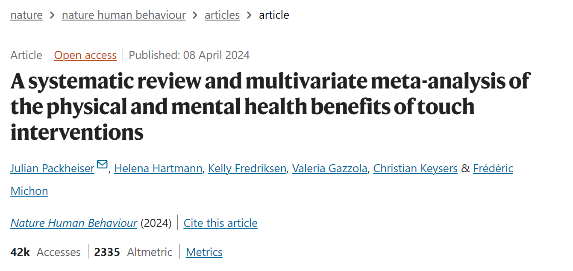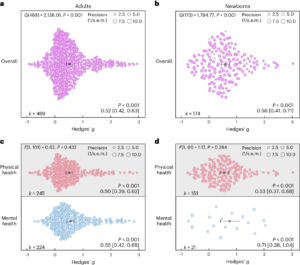We all seem to have experienced this: when feeling down and dejected, a comforting pat on the back from a friend helps release our emotions; on a stormy night, hugging a stuffed toy allows us to sleep peacefully; and during a first date with a lover, the subtle intertwining of hands sparks feelings of affection…
Touch is the earliest developed sense in the human body and is our most direct means of interacting with the world and others. It is not merely a sensory experience; it also triggers chemical reactions in the brain, releasing hormones and neurotransmitters that convey emotions, bringing us a sense of satisfaction and happiness. Touch plays an indispensable role in our lives.
1. The Benefits of Touch
Numerous studies have shown that touch benefits both mental and physical health. Touch can provide various physiological health benefits, including pain relief, blood pressure regulation, and cortisol reduction. Additionally, it can improve mental health by alleviating depression, reducing anxiety, and increasing positive emotions. However, because the type, pattern, and recipient of touch vary greatly, researchers have been exploring which kinds of touch are most effective for health.
In a systematic review and meta-analysis published this year in Nature Human Behavior [1], the authors analyzed 212 studies on touch, comparing the effects of different types, frequencies, and durations of touch, as well as the health status and age of the recipients. The analysis revealed that, overall, touch is beneficial for health, but many factors influence its effectiveness. These findings also provide insights for future research on touch and robotics.

▷ Packheiser, J., Hartmann, H., Fredriksen, K. et al. A systematic review and multivariate meta-analysis of the physical and mental health benefits of touch interventions. Nat Hum Behav (2024). https://doi.org/10.1038/s41562-024-01841-8
It is important to note that the touch in these studies was conducted with the knowledge and consent of both parties. Ignoring or violating someone's consent for touch can have negative effects. Although there is limited research on non-consensual touch due to ethical reasons, merely imagining non-consensual touch can evoke feelings of dirtiness and a desire to cleanse oneself, accompanied by negative emotions such as depression, anxiety, anger, and shame [2]. This phenomenon is known as "mental contamination." Therefore, consent is crucial in both research and practical applications of touch—do not touch others without their consent, no matter how much you desire it.
2. How to Enhance Effectiveness?
Research on adults indicates that physical touch significantly affects both physiological and mental health, with the most notable benefits being pain reduction and alleviation of depression and anxiety. Comparing different conditions of touch reveals more detailed insights.
The location of touch influences the health benefits it provides. Touching the head, compared to the arms and torso, offers greater health benefits. Therefore, head touches, such as scalp or facial massages, may be particularly effective in improving health. There is no significant difference between massage therapy and other forms of touch, suggesting that various types of touch offer similar benefits. Increasing the frequency of touch sessions can bring more benefits, especially in alleviating anxiety, depression, and pain. However, extending the duration of each touch session does not enhance the benefits and may even diminish the regulation of cortisol and heart rate.
Contextual factors such as the recipient’s gender, cultural background, internal state (e.g., stress level), and familiarity with the toucher significantly influence the perception of affective touch. To maximize the pleasure and health benefits of touch, these factors must be considered. For example, studies have found that touch more effectively reduces cortisol in women and that hugs better alleviate physiological stress in women than in men. Notably, affective touch is not limited to romantic partners and can occur between friends, acquaintances, or even strangers. Overall, women are more receptive to touch from people with varying levels of familiarity, a gender difference particularly evident in studies on same-sex touch [3].
Recent research also reveals that sensory pleasantness is influenced by gender and is related to the familiarity of the person providing the touch. However, since most studies on adult touch involve a majority of female participants, more research including male and non-binary participants is needed for more accurate conclusions. Additionally, older adults benefit more from touch in terms of improving positive emotions and lowering systolic blood pressure. This might be because, as age increases, baseline blood pressure also rises, providing more room for touch to have a regulatory effect.
Although most studies focus on clinical populations, touch also benefits healthy individuals. However, clinical populations tend to gain more mental health improvements from touch, likely due to a higher need for contact. Loneliness often accompanies chronic illness and is associated with feelings of depression and anxiety. Touch can help mitigate these negative conditions.
During the pandemic, social distancing measures were widely implemented to reduce COVID-19 transmission, inevitably limiting social interactions and touch. In the absence of touch, people might experience touch starvation, also known as skin hunger [4]. Studies have found that skin hunger is linked to stress, anxiety, and depression and may lead to aggressive behavior, self-harm, and eating disorders [5].
The pandemic’s restrictions on touch also prompt us to consider alternatives when human touch is not possible. Studies have found that body contact provided by objects (such as weighted blankets) or robots can also be beneficial. Physiologically, these benefits are comparable to those brought by human touch, but the mental health benefits are relatively less pronounced. Moreover, skin-to-skin contact has a better impact on mental health compared to other types of contact.

▷ Source: Andy Westface
Because touch involves interpersonal relationships that contribute to positive health effects, research on using robots to provide touch has not only focused on how robots can assume social roles but also on how to improve their relationship with the touch recipient.
Currently, common assistive robots are primarily divided into two categories: rehabilitation robots and socially assistive robots. Rehabilitation robots (e.g., intelligent wheelchairs, exoskeletons) primarily assist human rehabilitation through collaboration, while socially assistive robots cooperate directly with humans in touch-like interactions, performing tasks such as delivering items, cleaning, feeding, and providing companionship. These interactions offer psychological benefits and achieve mental health effects [6]. Additionally, researchers have developed synthetic skin in recent years to further enhance these mental health benefits by simulating skin contact.
Findings from neonatal research differ from those in adults. Neonatal touch research often focuses more on physiological health, frequently studying the benefits of kangaroo care. Kangaroo care involves placing the newborn upright against the parent’s chest, using the parent’s body heat instead of an incubator to provide warmth and security. However, studies have found no significant difference between kangaroo care and other types of contact regarding health benefits for newborns, allowing for flexibility in choosing different types of touch based on the situation.
Unlike in adults, where the familiarity of the toucher does not affect health outcomes, newborns benefit much more from being touched by their parents (often the mother in studies) than by strangers. Previous research has also indicated that early skin-to-skin contact and exposure to the mother’s scent are crucial for newborns to adapt to their new environment. These findings highlight the irreplaceable role of parental care during this period. Additionally, the familiarity of the location where the touch occurs does not influence the effect of touch. Moreover, the frequency of touch does not apply to newborns as it does to adults. In terms of various physiological health aspects, touch is most effective in promoting weight gain in newborns.

▷ Touch benefits both adults' and newborns' mental and physical health. Source: Julian Packheiser
3. Not Just for Humans!
Animal welfare has become a significant social concern in recent years. On one hand, pets have become integral family members, playing important roles as companions in many people’s lives. On the other hand, there is a growing awareness that even farm animals and laboratory mice should not be treated merely as tools; we should also strive to improve their well-being as much as possible within their limited lifespans.
Consequently, some experiments have examined the effects of touch on animals. Most studies have been conducted on rodents, including rats, mice, monkeys, cats, sheep, and coral fish. The primary forms of touch studied are stroking (lightly touching with the hand) and tickling (touching a body part to induce spontaneous movements or laughter).
Research has shown that touch can have positive physiological and quasi-psychological effects, indicating that human touch can also benefit animal health. For example, a 2014 study divided 139 anxious cats newly admitted to an animal shelter into a stroking group and a control group. The stroking group received gentle stroking (lightly touching the head and neck area while speaking softly) four times daily for ten days, each session lasting ten minutes [7]. The study found that the cats that were gently stroked daily exhibited fewer negative emotions (anxiety or irritation) compared to the control group and secreted more immunoglobulin A. Additionally, the incidence of upper respiratory diseases in the control group was 2.4 times higher than in the stroking group.
Another interesting study used a machine to simulate the tactile stimulation provided by cleaner wrasses (Labroides dimidiatus) to striped surgeonfish (Ctenochaetus striatus) for removing ectoparasites [8]. The cortisol levels of the surgeonfish significantly decreased when they received tactile stimulation from the machine compared to when they were in contact with a stationary machine. The results suggest that even without social interaction, mere touch can yield positive health effects. These findings can help improve animal welfare in laboratory settings, animal husbandry, and pet relationships.
Correspondingly, human-animal interaction is a crucial element of animal-assisted therapy, widely applied in treating conditions such as cognitive impairments, depression, and post-traumatic stress disorder. Studies have shown its potential for development in these areas [6,9].
4. Conclusion
In summary, touch is an innate ability and necessity for us. Whether it’s a loving hug, a friendly handshake, or a parent’s care for their child, we all have many warm memories associated with touch. However, in a world of rapid technological advancement, hectic work schedules, and sudden pandemics, we inevitably lose some opportunities for touch and, unknowingly, some of the positive emotions and sensations that accompany it. Hopefully, we can all utilize and enjoy touch, bringing comfort, relaxation, and happiness to ourselves and those around us during moments of fatigue and overwhelming stress.